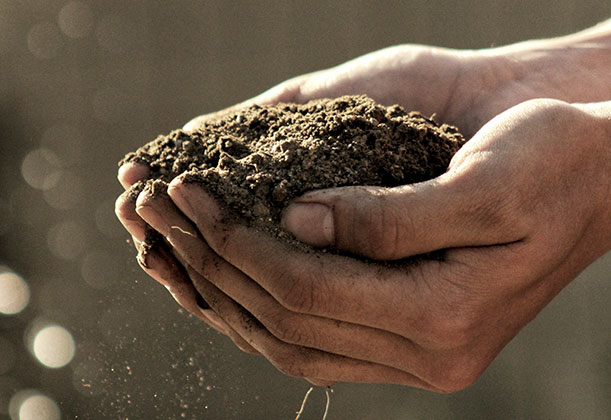BOOMbox at Home: Dirt and Soil
April 22, 2021

During spring, we're exploring the four elements of earth, air, fire, and water. This week, we’re investigating some of the fascinating properties of dirt and soil.
The Dirt on Dirt
You may be surprised that dirt and soil are not the same thing, although we often use these two words interchangeably. Dirt creates laundry. Soil provides food, shelter, and clothing. It’s the foundation holding up all of Earth’s cultures--past, present, and future. Without soil, we couldn’t build skyscrapers or create beautiful clay pots. There’d be no juicy fruit or crunchy veggies. Let’s dig into the dirt on soil.
Physicists estimate that nearly 30% of Earth is soil, but that small chunk supports us, directly and indirectly. While it’s technically a renewable resource, soil is created very slowly. According to the Soil Science Society of America,it takes from 500 to 1,000 years to create one inch of topsoil. Watch a video all about soil.
What Is Soil?
Soil has three types of particles: sand, clay, and silt. They are defined by size. Sand particles are the largest, silt is in the middle, and clay is the smallest. Soils contain different amounts of all three. Even though the ingredients of soil are always the same, the way they mix creates many different colors and textures of soil. Learn how to feel the differences in soils and try your own soil layers experiment at home.
Soil contains layers of rock, minerals, and organic material that are called horizons. It also contains air spaces and water. Soil horizons look like a layer cake. All soils have three main horizons, called A, B, and C:
Topsoil is horizon A. It’s made up of microorganisms mixed with decaying plants and animals. Topsoil is only about 5 to 10 inches thick.
Subsoil is horizon B. It’s made up of clay, iron, and organic materials.
The C horizon is called parent material because it’s made up of large rocks that eventually break down to create the upper layers. The base of the parent material is bedrock, the solid rock foundation of the looser layers above. Read more about soil biodiversity.
Many critters also live in soil, which helps to keep it healthy and growing. According to the Oregon State University Extension Service, one teaspoon (or one gram) of soil can hold billions of microscopic animals, including bacteria, fungi, algae, and protozoa. Larger animals that spend all or part of their lives underground include springtails, mites, nematodes, earthworms, ants. Larger animals who live in soil include moles, groundhogs, and gophers. Visit The Adventures of Herman (an earthworm) as well as The Bug Review to help identify insects. Watch a collection of videos about soil and it's many uses. Plants, animals, and humans all depend on healthy soil to live healthy lives.
Soil in Your Garden
Whether you live in a house or in an apartment, you can grow food, herbs, and flowers. Herbs are especially easy to grow in a sunny window, if you have space. The Botanic Garden has information on small-space vegetable gardens and specific information about plant profiles. The University of Illinois Extension First Garden website provides gardening basics. One of the first things to consider when gardening is the quality of your soil. Lucky for us, even if the soil we have isn’t very good, there are things you can do to improve soil quality.
One practical and fun way to start gardening is a pizza garden. Pizza gardens can be grown indoors and outdoors. Or both, if you start seeds inside and transplant the seedlings later in the spring. Another fun project is creating a terrarium mini-garden. Some locations have a Horizon 0, which is a top layer of twigs and leaves that sometimes covers Horizon A. Leaves are often used for art projects, but what about twigs? Here are nine twig crafts to try.
So Then, What Is Dirt?
Dirt started out as soil. But by the time parents ask us to remove our dirty shoes at the door, the soil has taken a journey from where it was intended to be. Dirt is soil that is out of place. It has also lost the nutrients and minerals needed to support life, so it’s basically dead soil. But that doesn’t mean you can’t have fun with dirt.
How about doing some dirt painting? All you need is dirt and painting supplies. Gather a container, brushes, water, dirt, and paper. Mix the dirt and water to make a thick liquid. Use brushes or fingers to paint. If you want to be extra artistic, look for different types of soil to create shades of paint.
For years, parents have tried to convince their children that it’s not good to play in dirt or mud. Turns out, they’re wrong. Adults might be trying to reduce the laundry load or how often they need to mop the floors, but Mayo Clinic confirms that playing in the mud is actually good for you (and it's maybe even okay to eat it). So get out there and enjoy playing in the dirt.
Scientist of the Week
Asmeret Asefaw Berhe is a professor of soil biogeochemistry and interim associate dean of the Graduate Division at the University of California, Merced. She studies how soil helps regulate the Earth's climate and the effect of erosion, fire, and climate change on soil. She was raised in Eritrea, a country in northeast Africa that borders the Red Sea. Her 2020 Time magazine article exposes the lack of attention on food insecurity and poverty, and the impacts of climate change on Black and brown communities. In her 2019 TED Talk she said "[Soil] represents the difference between life and lifelessness in the earth system, and it can also help us combat climate change--if we can only stop treating it like dirt." The TED talk also was made into a comic strip.
Written by Pam.